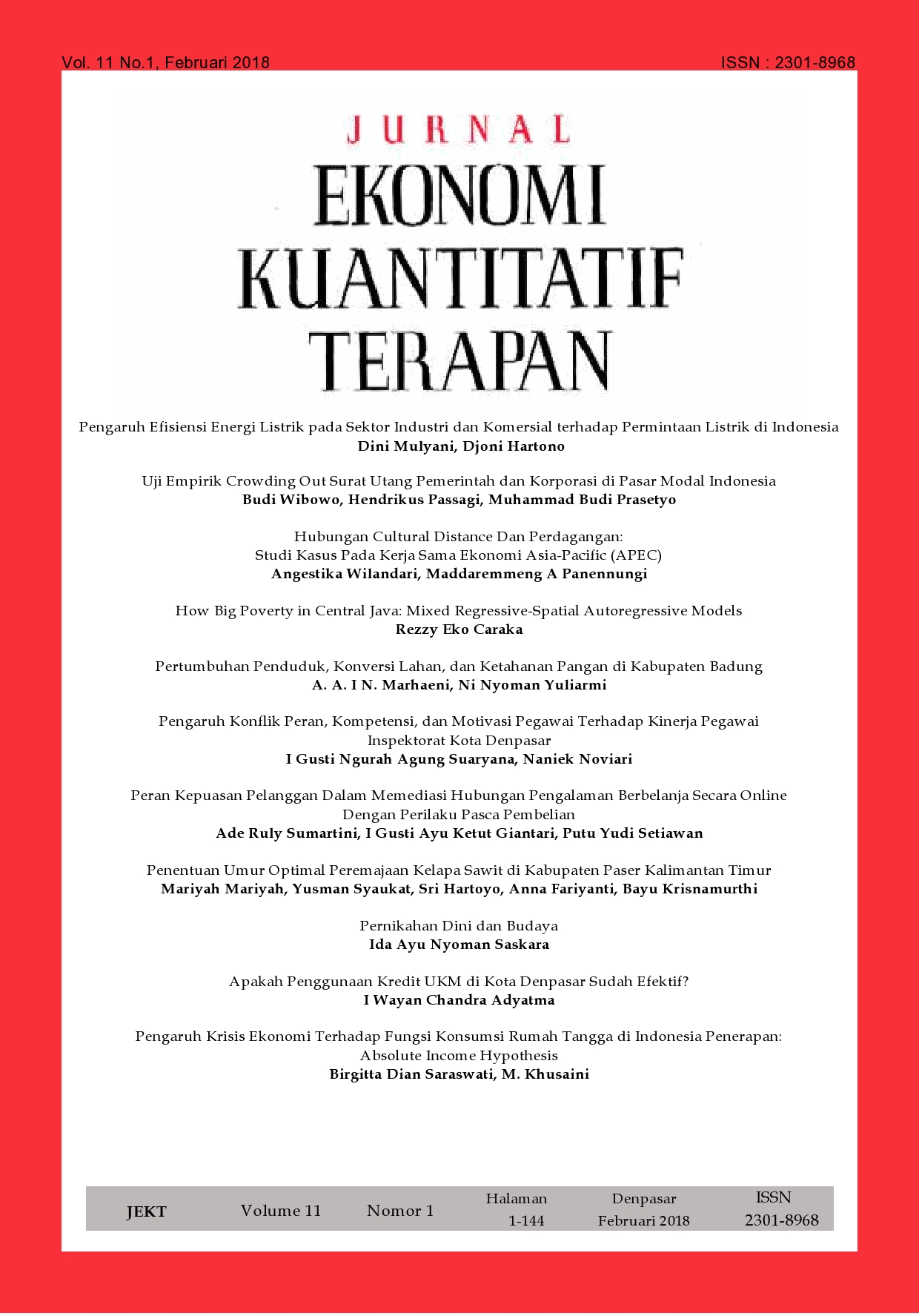Pengaruh Efisiensi Energi Listrik pada Sektor Industri dan Komersial terhadap Permintaan Listrik di Indonesia
Abstract
Effective and efficient electricity consumption is one of the main concerns of Indonesian government. Indonesian electricity consumption has been growing rapidly in the last decade. It is predicted that total electricity consumption will continue grow with faster growth rate. Therefore, immediate actions on the demand side arenecessary through electricity consumption efficiency. The study employs a dynamic panel approach on the panel data of 31 provinces in Indonesia during the period 20014-2013. The results suggest that aggregate electricity demand can be reduced through efficiency on electricity consumption in industrial and commercial sector. The study also reveals that real GRDP, population, and changes in the economic structure have a positive and significant impact on the electricity demand. On the other hand, the effect of real electricity price on electricity demand is not statistically significant.
Downloads
References
Adom, P.K., & Bekoe, W. (2012). Conditional dynamic forecast of electrical energy consumption requirements in Ghana by 2020: a comparison of ARDL and PAM. Energy, 44(1), 367–380.
Adom, P.K., & Bekoe, W. (2013). Modelling electricity demand in Ghana revisited: the role of policy regime changes. Energy Policy, 61, 42-50.
Alter, N., & Syed, H.S. (2011). An empirical analysis of electricity demand in Pakistan. International Journal of Energy Economics and Policy, 1(4), 116–139.
Arellano, M., & Bond, S. (1991). Some tests of specification for panel data: Monte Carlo evidence and an application to employment equations. The Review of Economic Studies, 58(2), 277–297.
Arellano, M. (2003). Panel Data Econometrics. Oxford: Oxford University Press.
Arimah, B.C. (1993). Electricity consumption in Nigeria: a spatial analysis. OPEC Energy Review, 17(1), 63–82.
Arnaz, M.Z. (2014). Permintaan Energi Listrik Agregat dan Rumah Tangga di Indonesia. Tesis Magister, Tidak Dipublikasikan. Fakultas Ekonomi Universitas Indonesia.
Atakhanova, Z.,& Howie, P. (2007). Electricity demand in Kazakhstan. Energy Policy, 35(7), 3729–3743.
Bhattacharyya, S.C. (2011). Energy economics: concepts, issues, markets and governance. Springer Science and Business Media.
BPPT. (2012). Perencanaan Efisiensi dan Elastisitas Energi 2012. Jakarta: Balai Besar Teknologi Energi Badan Pengkajian dan Penerarapan Teknologi.
Burney, N.A. (1995). Socioeconomic development and electricity consumption: A cross-country analysis using the random coefficient method. Energy Economics, 17(3),185–195.
De Keulenaer, H., R. Belmans, E. Blaustein, D. Chapman, A. De Almeida, and B. De Wachter. (2004). Energy efficient motor driven systems.
Departemen Energi dan Sumber Daya Mineral. (2005). Blueprint Pengelolaan Energi Nasional 2005–2025.
Dewan Energi Nasional. (2014). Ketahanan Energi Indonesia 2014. Jakarta: Dewan Energi Nasional. Diakses 8 September 2015 .http://www.den.go.id/index.php/publikasi/download/15.
Direktorat Konservasi Energi, KESDM. Menyiasati Kenaikan Tarif Dasar Listrik dengan Penerapan Manajemen Energi ISO 50001. Diakses 17 September 2015 http://aplikasi.ebtke.esdm.go.id
Ekpo, U.N., Chuku, C.A.,& Effiong, E.L. (2011). The dynamics of electricity demand and consumption in Nigeria: Application of the bounds testing approach. Current Research Journal of Economic Theory, 3(2), 43–52.
Energy Information Administration. Annual Energy Review 1995. US Department of Energy, Washington DC, July 1996.
Farrell, M.J. (1957). The measurement of productive efficiency. Journal of the Royal Statistical Society. Series A (General), 120(3), 253–290.
Fatai, K., Oxley, .L, & Scrimgeour F.G. (2003). Modeling and forecasting the demand for electricity in New Zealand: a comparison of alternative approaches. The Energy Journal, 24(1), 75-102.
Filippini, M., & Hunt, L.C. (2015). Measurement of energy efficiency based on economic foundations. Energy Economics, 52, S5-S16.
Hansen, L.P. (1982). Large sample properties of generalized method of moments estimators. Econometrica: Journal of the Econometric Society, 50(4), 1029-1054.
Inglesi, Roula. (2010). Aggregate electricity demand in South Africa: conditional forecasts to 2030. Applied Energy, 87, 197–204.
IEA. (2010). World Energy Outlook 2010. Paris: International Energy Agency. Diakses 9 September 2015. http://www.worldenergyoutlook.org/media/weo2010.pdf.
KESDM. (2015). Rencana Umum Ketenagalistrikan Nasional (RUKN) 2015-2034. Kementerian Energi dan Sumber Daya Mineral.
Lin, B.Q. (2003). Electricity demand in the People’s Republic of China: investment requirement and environmental impact. ERD Working Paper Series No. 37.Economics and Research Department–Asian Development Bank.
Lovins, A.B. (2005). Energy End-Use Efficiency. Report No. E05-16. Rocky Mountain Institute.http://www.rmi.org/cms/Download.aspx?id=4979&file=Energy+End-Use+Efficiency.pdf&title=Energy+End-Use+Efficiency
Maddigan, R.J., Chern, W.S., & Rizy, C.G. (1983). Rural residential demand for electricity. Land Economics, 59(2), 150-162.
Narayan, P.K., & Smyth, R. (2005). Electricity consumption, employment and real income in Australia: Evidence from multivariate Granger causality tests. Energy Policy, 33(9), 1109–1116.
Patterson, M.G. (1996). What is energy efficiency?: Concepts, indicators and methodological issues. Energy Policy, 24(5), 377–390.
Perloff, Richard M. (2008). The Dinamic of Persuasion: Communication and Attitudes in the 21st Century. New York. Lawrence Erlbaum Associates. Taylor and Francis Group.
Pindyck, Robert S. and Daniel L. Rubinfeld. (2013). Microeconomics Sixth Edition. New Jersey: Pearson Education.
PT. PLN (Persero). Statistik PLN (berbagai terbitan 2004-2015). Jakarta: PT. PLN (Persero).
PT PLN (Persero). (2015). Rencana Usaha Penyediaan Tenaga Listrik (RUPTL) 2015-2024. Jakarta: PT PLN (Persero).
Pusdatin ESDM (2014). Handbook of Energy & Economic Statistics of Indonesia. Ministry of Energy and Mineral Resources Republic of Indonesia. Diakses 5 september 2015. https://www.esdm.go.id/assets/media/content/content-handbook-of-energy-economic-statistics-of-indonesia-2014-it06jkm.pdf
Sa’ad, S., 2009. Electricity demand for South Korean residential sector. Energy Policy, 37(12), 5469–5474.
Samuelson, Paul A. dan Nordhaus, William D. (2001). Microeconomics. Seventeenth Edition. McGraw-Hill Higher Education.
Ubani, O. (2013). Determinants of the dynamics of electricity consumption in Nigeria. OPEC Energy Review, 37(2), 149-161.
Verbeek, M. (2008). A guide to modern econometrics, 3rd Ed. Chichester: John Wiley & Sons. Ltd.
Worrell, E., Bernstein, L., Roy, J., Price, L., & Harnisch, J. (2009). Industrial energy efficiency and climate change mitigation. Energy Efficiency, 2, 109.
Xenergy, Inc. (1998). Evaluation of the US Departement of Energy Motor Challenge Program.




















